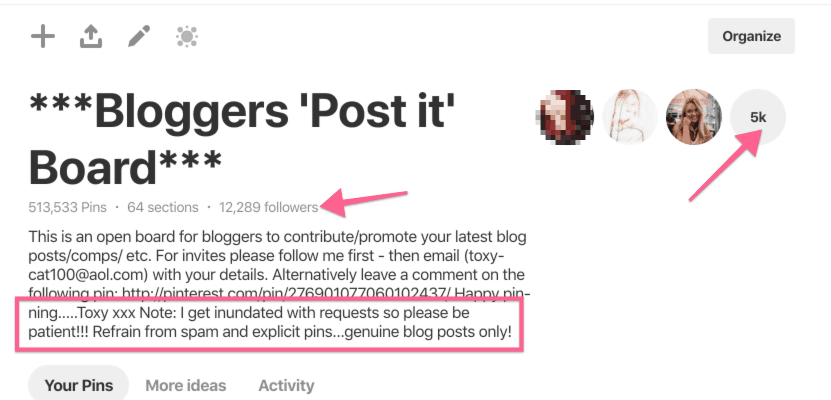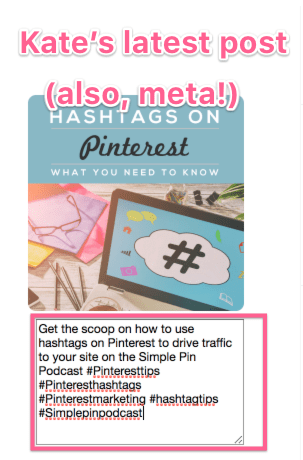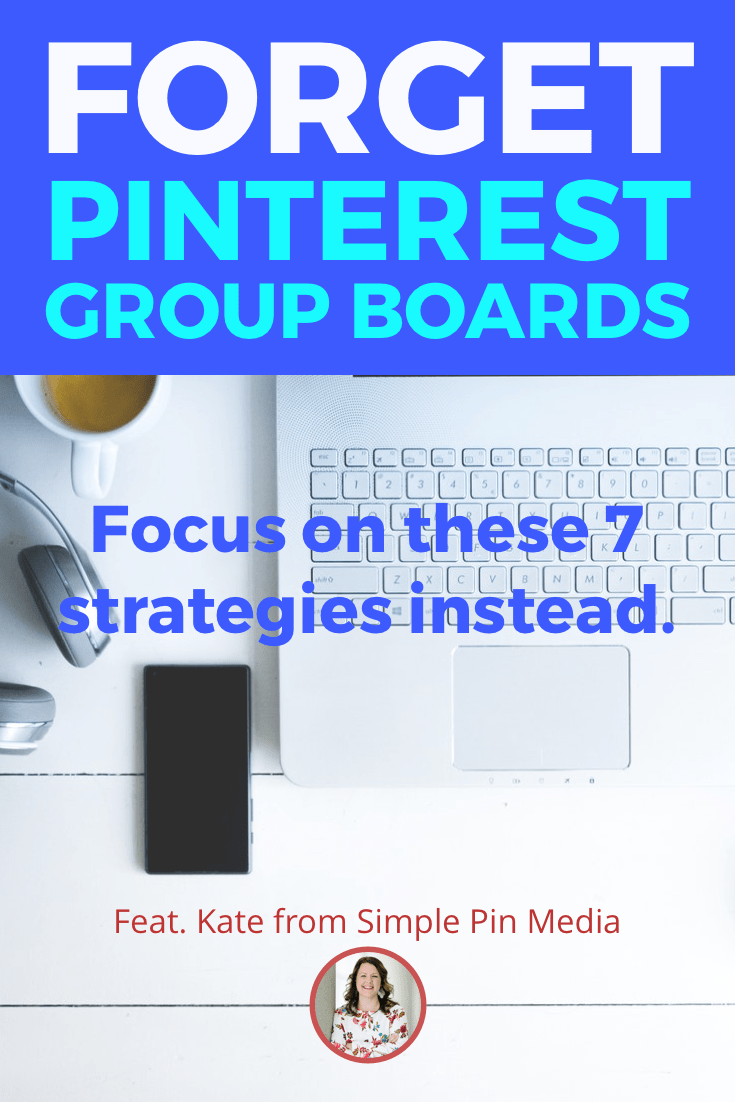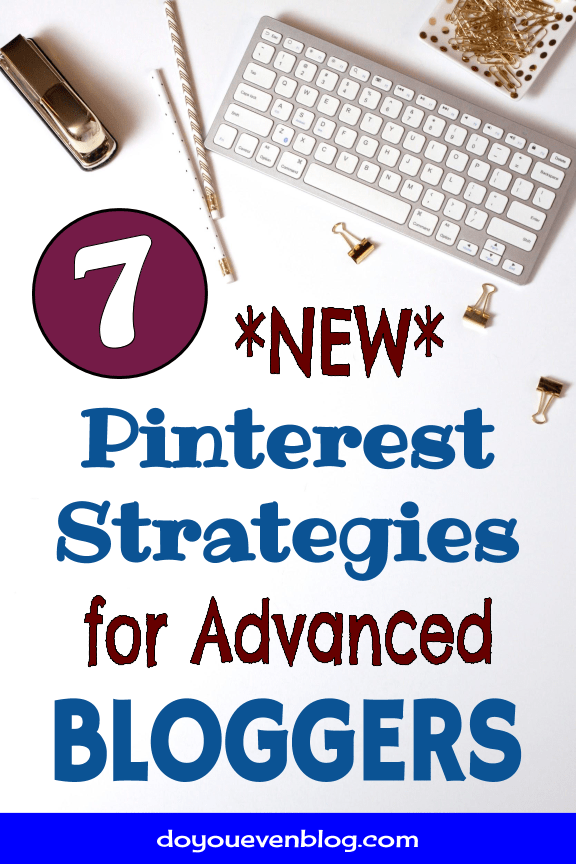If you’re into Pinterest marketing–Kate Ahl from Simple Pin Media is about to blow your mind.
We’ve all seen uber-huge Pinterest traffic stories and heard the advice…
- “Get on MORE group boards!
- Pin 35 times a day!
- Do this exact strategy that worked for me 16 months ago!”
Well no more.
In this post, Kate walks us through how to market your blog on Pinterest to drive traffic ASAP.
Listen to my episode with Kate Ahl from Simple Pin Media
or listen on Apple Podcasts \\ Google Podcasts \\ SpotifyOk. Let’s dive into some contrarian and semi-unconventional Pinterest marketing tips that might help you stand out.
Also, don’t miss this video I did with Kate as well!
Pinterest wants “fresh pins” now
More than ever before, Pinterest has gone on record citing they want “fresh content” or “fresh pins.”
So what do they mean?
Pinterest doesn’t want their platform spammed with the same images, over and over again. They want LOTS of different images, even if it uses the same pin description and points to the same blog post.
For each post, make multiple pins. Constantly.
THIS is what Pinterest is going big on right now. “Fresh” pins.
Group Boards Are Never Coming Back…
…to the way they were a year ago.
Are they still useful?
Potentially.
Should you base 90% of YOUR Pinterest strategy based on the success of existing bloggers like Chasing Foxes (who grew to 2M+ page views a month in roughly a year thanks to smart and savvy pinning–mainly to group boards)?
No. The game has changed. Probably for good.
Pinterest has been slowly decreasing the effectiveness of group boards for a while, and when you think about it, this makes sense.

The current “use” of group boards (i.e. applying to a ton of them, pinning several dozen times a day across all group boards, and only using your personal boards to share other people’s content, etc)–was never in line with Pinterest’s original idea of what group boards should be.
They figured small groups of people who knew each other would create group boards for specific projects.
Think: planning a wedding.
Instead, they got 500k bloggers “abusing” the system (not illegally).
The two ways to incorporate group boards for any strategy going forward:
- Be 10x more selective when apping to boards
- Consider them a secondary strategy only AFTER your foundation is solid (see below)
We’ll hit #2 in a second.
As for the first one, Kate dropped a few tips for your group board strategy:
Namely, only consider pinning to group boards with…
- A TINY amount of contributors (think less than 10)
- A very specific name (and thus topic/niche)
- People who you KNOW produce A+ content
Anything else is likely a waste of your time in regards to driving Pinterest traffic.
So if group boards are becoming less and less relevant and powerful, what then should we focus on?
- Your personal brand
- Images
- Discoverable pins (descriptions & hashtags)
Foundation 1 – Focus on Your Pinterest Brand
Per Kate, here’s what you should focus on first and foremost.
- your personal profile
- your personal boards
Actually–focus on your content above all else (added by Pete).
After that, focus on the USER EXPERIENCE anybody has when landing on your profile or viewing your pin in their smartfeed.
If you’re feeling “duh” while reading this, I wouldn’t be surprised.
However, I’d challenge you to ask yourself this: Is every single pin and board on my profile filled with quality content?
Nope.
Not a single one of you can say this.
We’ve all repinned other people’s content from Pinterest or Tailwind Tribes–for no other reason other than “to pin other people’s content.”

Think about this from Pinterest’s perspective.
- they want to serve A++ content to their users
- you’re helping spread C– content (extreme example).
Why on Earth would Pinterest reward us for this?
As the Pinterest algorithms (and developers) get smarter and smarter–you can bet money on them favoring and rewarding pinners with a clean & specific brand filled with A++ content that has been actually curated.
Action Items:
- Clean out crap pins in your boards?
- Clean out generic or non-specific boards
- Make sure you’re only pinning high-quality content.
I.e. actually high-quality content.
I.e. literally, digitally, and physically pinning high-quality content you didn’t just spam-pin from a Tailwind Tribe.
Savvy?
For a successful pinning strategy–take actions that make your boards shine. YOUR profile shine.
Foundation 2 – Images Are Still (and Will Always Be) Your Highest Priority
You’ve heard this before.
“Make good images!” they said.
Out of all the various aspects of testing and analytics–this might get my vote for the #1 thing to focus on.
I’m also going to point you to Kate’s own blog for this. No need to copycat content here: How to A/B Test Pinterest Images
Foundation 3 – Pin Descriptions.
The goal? Get your pins discovered precisely when your target reader needs them.
The way?
I could probably take up an additional 1,000 words in this post for this, but that’d be stupid.
Here’s how Kate broke it down:
- One to Two sentences, casually written, mentioning your keywords
- Some hashtags.
Well, that was easy.

Ok then. Implemented.
Moving on.
Bonus Foundation 4 – Ask Your Audience to Follow and Pin!
While this also seems like a “duh” comment–I hereby admit to not doing this.
Kate shared this tip as one of her top-5 takeaways from the In the Making Pinterest conference back in June.
Think about this, it’s totally in Pinterest’s best interest.
They want more pinners on their platform. More users. (and hey, more advertisers).
Pinterest wants you to bring your audience to their platform. For us bloggers–that looks like “us asking them” to follow and pin.
That makes sense.
Speaking of which…
The Do You Even Tribe is MORE than welcome to follow me on Pinterest here, and of course, save this post for later using this pin!

Winning.
What’s next?
Remember: Pinterest Is A “Slow Burn”
Think SEO.
NOBOBDY can start a blog one week (using my all-comprehensive guide to their first 12 months), then immediately rank for high-competition keywords the next week.
Any SEO knows the importance of a long-term commitment and patience–and Pinterest requires this, too!
Any content posted on these platforms is designed to exist only in the short-term, and also provide immediate, short-term results. “Quick clicks.”
Not Pinterest.
Pinterest is a search engine…or is it?
Pinterest Is NOT a Search Engine. It’s a Discovery Engine.
Google is a search engine.
Yes, pins are still found based on keywords.
Yes, I’m aware this is a fine line–but it brings up an important point.
There are a few crucial differences between actual search engines and the way Pinterest works. Namely, different keywords, user intent, and user “interests.”
Kate even mentioned her own searching behavior on the podcast.
- When she’s seeking immediate answers or solutions to a problem, she heads to Google.
- When she’s looking for ideas, inspiration, or compiling many different “solutions” to circle back to later, she heads to Pinterest.
So what does this mean for our pins and blog traffic?
First, we need to remember that Pinterest is a long-term game.
Somebody could “view” and even “repin” our content–but not actually click-through and visit our site for days, weeks, or months.
Second, we need to design our pins to be “discovered,” and this looks different than it does on Google.
For one, #hashtags.
For two, the image, description, board name, and probably even your profile/brand helps Pinterest show your pin in peoples’ smartfeed based on interests.
If you head to Pinterest and log-in to your account–you’ll see pins before you’ve ever searched for anything.
This is based on…
- People you follow
- Interests based on past clicks
- Interest defined in your settings
- Probably more we don’t even know about.
The point is, Pinterest is a discovery engine, in addition to simply showing pins with our keywords when somebody actually searches.
There’s no smartfeed on Google.
Pin in Seasons
Ok, you’re finally allowed to think “duh” on this one.
People have different interests in each season, and it can be different across niches.
- Fashion in October = people searching for and discovering trendy upcoming winter clothing ideas
- Personal finance in late December and early January = people hoping to get back on track in the New Year
- Fitness in late December and early January = same thing.
Think through your audience’s pain points–are there any seasons that obviously stand out?
Start creating content and pinning at least 45 days prior to “the season.” This was Kate’s advice allowing for Pinterest to fully take your content into consideration in time…
…as well as simply beating competitors to the punch 😉
Here’s a summary of a solid Pinterest marketing foundation for 2018 and beyond:
1 – Continue to focus on improving your image quality.
2 – Descriptions need to be discoverable. This could look as simple as 1-2 sentences, casual and conversational in nature, mentioning your keywords, then a few hashtags.
3 – Focus less on making sure you’re on every group board under the sun, especially those with a high level of contributors and low followers. This could actually do more harm than good.
4 – Focus on your brand (profile and boards, as well as pins within your boards). Provide a good user experience to anybody who follows you on Pinterest. This means actually curating the content and pinning good stuff!
5 – Continually encourage and ask your audience to follow your profile and pin your content.
6 – Ignore the constantly-changing little tweaks you hear around the Pinterest blogosphere. Focus on your brand, your images, and being discoverable. These strategies will never be taken away from Pinterest.
If you’re wondering where to go from here, I’d suggest a few things.
- Head to Kate’s site and subscribe to her weekly newsletter.
- Listen to my episode with Rosemarie Groner on Pinterest. It’s more timeless than other Pinterest content I’ve produced.
- Opt-in to my own newsletter.
Ok, so that last one isn’t Pinterest-specific, but I can promise you that I have bloggers’ best interest at heart, and will always strive to give you A++ content you can pin to your followers 😉

Feel free to drop a comment if you enjoyed this episode as well!

